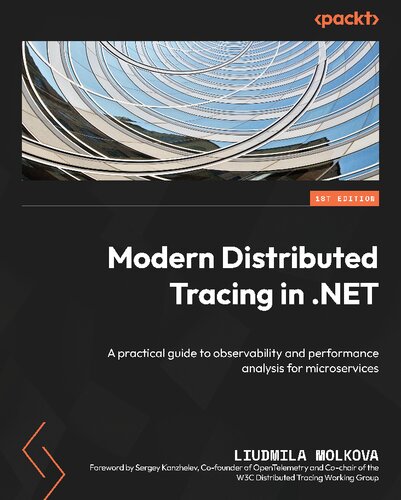

Most ebook files are in PDF format, so you can easily read them using various software such as Foxit Reader or directly on the Google Chrome browser.
Some ebook files are released by publishers in other formats such as .awz, .mobi, .epub, .fb2, etc. You may need to install specific software to read these formats on mobile/PC, such as Calibre.
Please read the tutorial at this link: https://ebookbell.com/faq
We offer FREE conversion to the popular formats you request; however, this may take some time. Therefore, right after payment, please email us, and we will try to provide the service as quickly as possible.
For some exceptional file formats or broken links (if any), please refrain from opening any disputes. Instead, email us first, and we will try to assist within a maximum of 6 hours.
EbookBell Team

4.4
32 reviewsInstrument .NET apps using OpenTelemetry and explore logs and .NET diagnostic tools to debug, monitor, and analyze the performance of complex systems in the cloud
Purchase of the print or Kindle book includes a free PDF eBook
Key FeaturesAs distributed systems become more complex and dynamic, their observability needs to grow to aid the development of holistic solutions for performance or usage analysis and debugging. Distributed tracing brings structure, correlation, causation, and consistency to your telemetry, thus allowing you to answer arbitrary questions about your system and creating a foundation for observability vendors to build visualizations and analytics.
Modern Distributed Tracing in .NET is your comprehensive guide to observability that focuses on tracing and performance analysis using a combination of telemetry signals and diagnostic tools. You'll begin by learning how to instrument your apps automatically as well as manually in a vendor-neutral way. Next, you'll explore how to produce useful traces and metrics for typical cloud patterns and get insights into your system and investigate functional, configurational, and performance issues. The book is filled with instrumentation examples that help you grasp how to enrich auto-generated telemetry or produce your own to get the level of detail your system needs, along with controlling your costs with sampling, aggregation, and verbosity.
By the end of this book, you'll be ready to adopt and leverage tracing and other observability signals and tools and tailor them to your needs as your system evolves.
What you will learnThis book is for software developers, architects, and systems operators running .NET services who want to use modern observability tools and standards and take a holistic approach to performance analysis and end-to-end debugging. Software testers and support engineers will also find this book useful. Basic knowledge of the C# programming language and .NET platform is assumed to grasp the examples of manual instrumentation, but it is not necessary.
Table of Contents